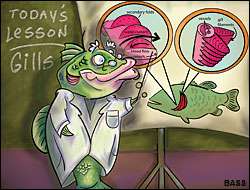
If sharks had feet, they would wear out a lot of shoes.
Many species of sharks, along with tuna, must constantly move in order to breathe. That can make it tough to get a good night’s sleep.
Bass and most other fish are lucky. Like us, they can breathe even when they’re not moving, and like us they breathe to put oxygen into their bodies, so they can live.
But bass, sharks and all other fish are very different from us in how they get that oxygen. We breathe in air so that our lungs can obtain oxygen. By contrast, fish push water through their mouths and across their gills, which take in the oxygen that they need. Most fish just open and close their mouths to push the water, while tuna and some sharks must move to do so.
Having gills makes a bass a real “fish out of water” when you pull it onto shore or into your boat. Unless you treat it with care and put it quickly into a livewell or back into a lake or river, it will die because it cannot get the oxygen it needs from air.Some species, such as catfish, can live longer out of water than others, but it’s always a good idea to return a fish to water as soon as possible.
In its watery world, a bass breathes by opening its mouth and drawing in water. As it does that, it closes its gill covers tight over its gill openings. Then it closes its mouth and drives the water over its gills and out with special throat muscles.
Gills are those bright red feathery organs that you see beneath the gill covers, or operculum, on the side of a fish’s head. As water is passed through, oxygen is absorbed through the gills and into the fish’s blood. From there, arteries take it throughout the body. As the oxygen is used up by the stomach, brain, liver and other vital organs, the blood flows to the heart, where it is pumped back to the gills.
Some water is better for breathing than other water. That’s why you should keep your livewell — and your aquarium at home — aerated. That means using turbulence from a pump to put oxygen into the water.
You must do this because fish, like us, produce carbon dioxide as waste when they breathe. In a closed container without aeration, a fish would soon use up all of the oxygen and die of suffocation, just as it does when left out in the air for too long. Turbulence replaces the carbon dioxide with life-giving oxygen.
Pumping in oxygen becomes even more important as the water heats up. That’s because warmer water can’t hold as much oxygen as cooler water. Also, a bass needs more oxygen in hot weather because it is cold-blooded, and higher temperatures make it more active.
Bass sometimes die in small, shallow ponds during summer because the water is so warm that it can’t hold enough oxygen for the fish to survive.
In the North, they also might die of suffocation in the winter, when ponds and lakes freeze over. Ice keeps the water from absorbing oxygen from the air. Also, snow cover on the ice can be a killer since it prevents sun from reaching underwater plants. Without sunlight, plants don’t take in the water’s carbon dioxide and release the oxygen that fish require.But such “kills” don’t mean that bass are delicate creatures compared to other fish. Under the same circumstances, just about any other freshwater species would die as well.
Actually, bass are among the most hardy and adaptable fish in the world, which is why we can fish for them in 49 of the 50 states, from the icy waters of Montana to the sun warmed waters of Florida.
Wherever you catch them, though, don’t forget that a bass needs water in the same way that you need air. As quickly as you can, let that fish breathe again.

